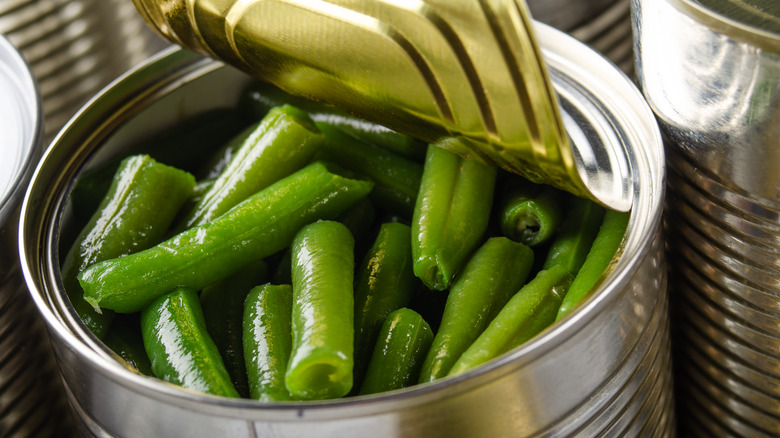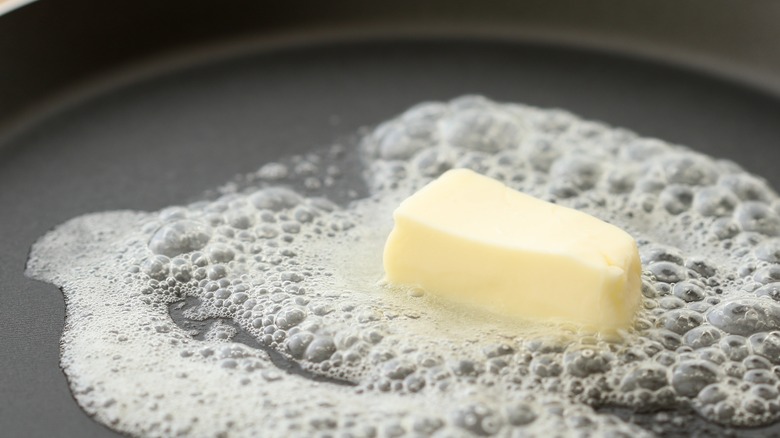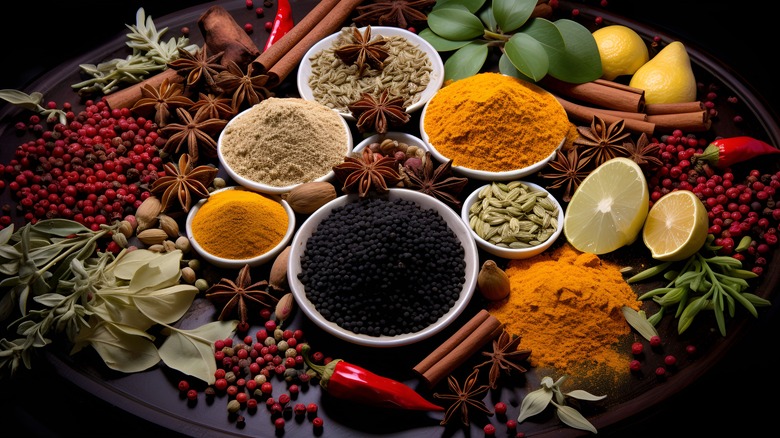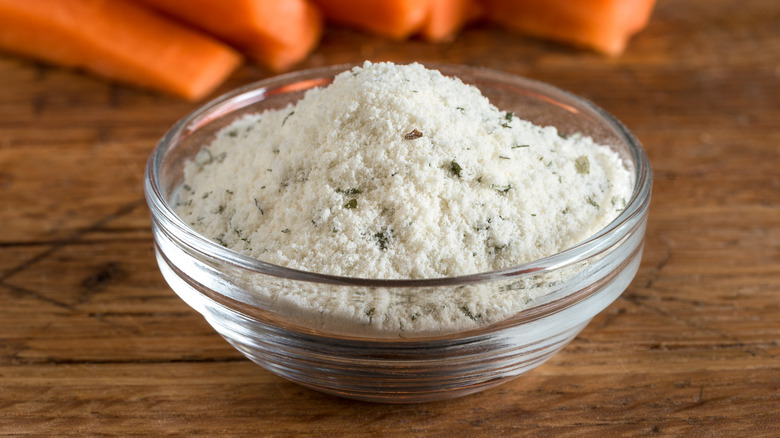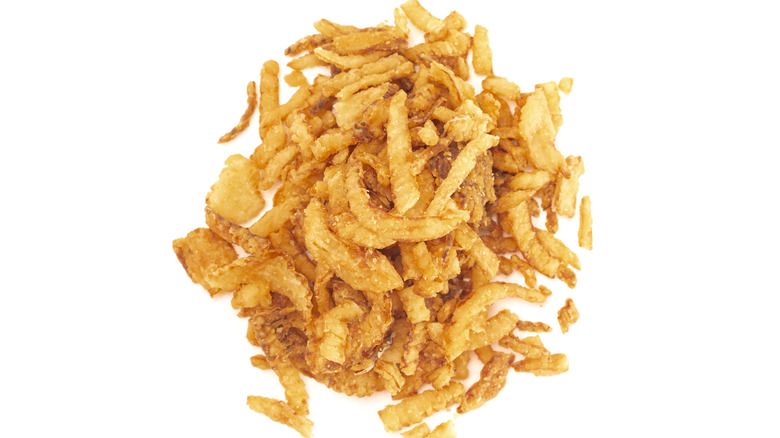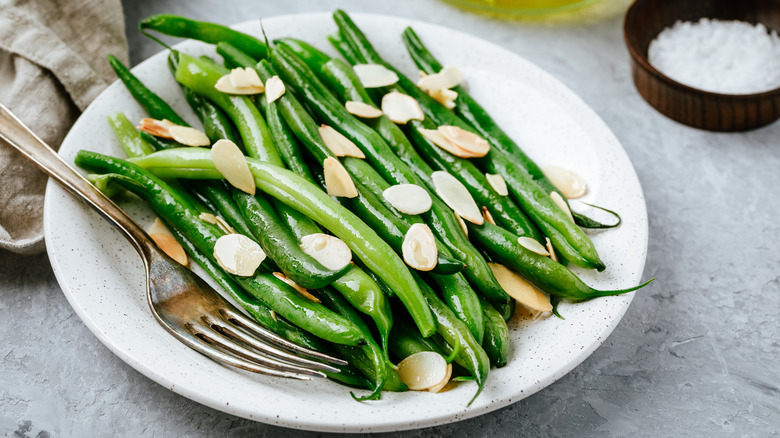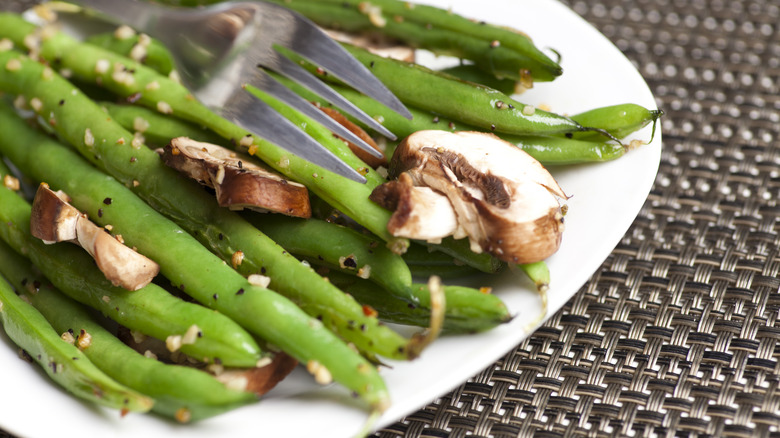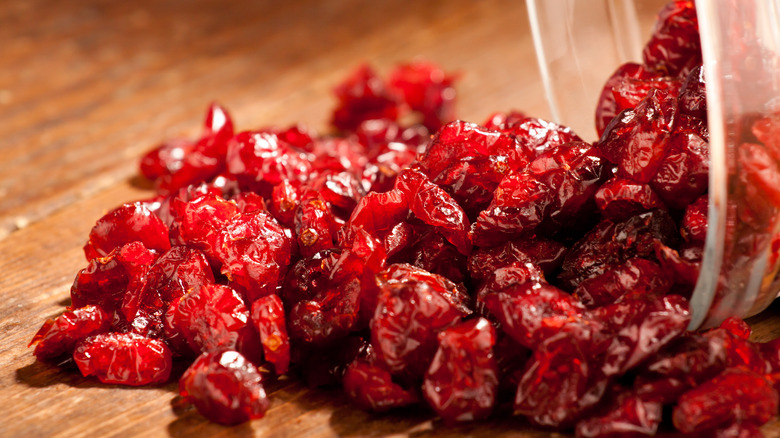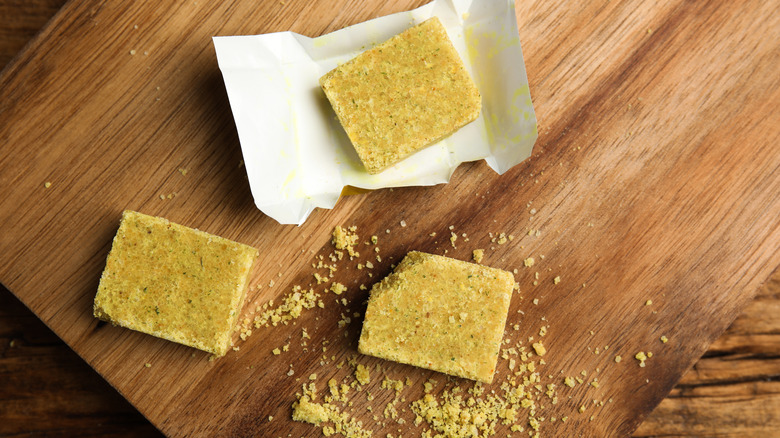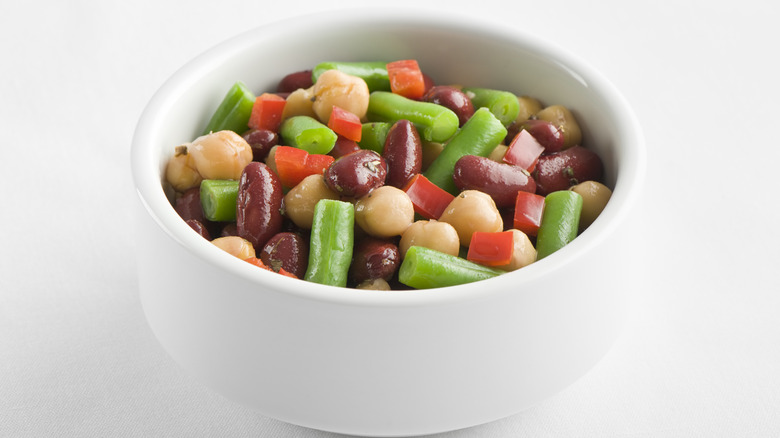Add These Ingredients To Canned Green Beans And Thank Us Later
Canned green beans are cheap and convenient, but they can taste plain and oddly tangy, which isn't to everyone's taste. Green beans also tend to be kind of soft. Yet they're so easy to find and so nutritious that it doesn't make sense to avoid them, assuming you're not allergic to them. You just need ways to give those green beans some oomph and make them taste much better than they do straight out of the can.
The good news is that canned green beans soak up flavors easily and pair well with all kinds of foods, which can improve the final dish's texture. Whether you want a light side dish for summer or a savory snack, you can find something that will turn your green beans into a dish to remember. Here's a list of ingredients you can use to make those canned green beans taste less like something that you dragged out of a back corner in your pantry and more like something you'll want to eat again and again.
Bacon
This first one shouldn't be much of a surprise. After all, ham and green beans are a well-known pairing, so using bacon to spruce up this vegetable is a natural extension of that. You've got a couple of options. You could add some fried and crumbled bacon as a topping for the green beans right before serving them, or you could fry the bacon and then add the beans and some water to the same pot, and let the beans cook in the bacon-water concoction on low heat for a couple of hours. You'll get more bacon flavor in the beans with the second method, but it will obviously take longer. With just a few more ingredients, you can make bacon and green beans the star of your meal with this copycat Texas Roadhouse green beans recipe.
Bacon has another characteristic that could keep you coming back for more: It may actually be a rather addicting food. That isn't a joke — the saltiness and fattiness of bacon make it an almost perfect candidate for food addiction. A 2015 study from the PLoS One journal found that processed foods were associated rather closely with addiction-like eating habits. This means you should watch how much bacon you add and how often you make dishes with bacon and green beans because you could easily have more of it than you intended to eat.
Butter
How does that saying go? "Butter makes everything better?" It's very true for vegetables, including canned green beans. Pouring melted butter over the green beans or sauteing the vegetables in melted butter gives the beans a lovely, buttery taste while coating them in a sheen of fat that makes them look so appetizing and rich. If you or anyone in your family just can't stand the taste of canned green beans, sauteing the vegetables in salted butter should cover up much of the beany taste.
Be aware that canned beans already contain salt, so adding salted butter will increase the sodium content even more. If you are monitoring your salt intake, consider using low-salt or no-salt canned green beans or even unsalted butter.
You should also note the one issue with butter, which is that it can burn easily. Lightly browning the butter is one thing — that can taste very nice. But butter has a low smoke point and can actually burn, which makes it taste bitter. Keep the heat low when using butter for your green beans, and keep an eye on the color. Stir the butter and beans constantly. If the butter is a light to light-medium brown, you've only browned the butter and given it a nutty taste. But if it turns a dark brown, it's burnt and won't taste good. At that point, you'll want to start over with another can of beans and fresh butter.
Herbs and seasonings
While using herbs and seasonings with canned green beans may not be the most earth-shattering choice, it's still worth mentioning. People often forget that small changes like adding a little garlic powder can make all the difference. One important thing to note about using spices is that they not only have their own distinct taste, but they also fall into categories like delicate, strong, sweet, and savory. If you want to give canned beans a medium (not strong but not delicate) flavor but don't want garlic, try basil, dill, or thyme instead. If you want a peppery taste but don't want to use pepper, mustard would be an option. Want to see if a sweet combination would work? Try cardamom or fennel. Be aware that cardamom is also considered a strong flavor while fennel is a medium flavor.
Try both dried and fresh herbs to see how they differ. Add fresh herbs after seasoning the beans with salt and pepper, or try using dried spices and herbs in place of salt. If you're serving the green beans to kids or to adults who just do not like vegetables, the herbs and spices could help them eat more of the dish. A 2018 study in the Food Quality and Preference journal found that herbs and spices increased positive views of vegetables among rural high school students; the teens ate more vegetables when they were seasoned with herbs and spices as compared to seasoning with just salt and oil.
Ranch seasoning powder
Powdered ranch seasoning may not seem like the most obvious addition unless you're a major ranch dressing fan — especially because you could just pour ranch dressing itself on the beans like you would a salad. But sprinkling a little powder onto the beans allows you to add more of that distinct ranch flavor without making them gooey. The powder also provides fewer calories than you'd get with the dressing. Other options include mixing the ranch powder into Greek yogurt or cottage cheese to form a low-calorie dip for individual green beans.
You can get shaker containers of the ranch dressing powder if you plan to use it a lot, or you can keep a few packets of the dressing mix around and sprinkle a little powder on green beans now and then. Remember that the moisture on the beans will likely make the powder dissolve a bit. You can try cooking the beans a little to see if the moisture will evaporate.
Lemon juice
Canned green beans do have that weird, almost-sharp taste straight out of the can, and that may make eating a lot of the beans rather unpleasant. Yes, some of you might love that taste, and that's good! But for those of you who aren't thrilled with the flavor, there is an option that doesn't involve extra cooking or adding anything else that would increase the bulk or size of the final dish. The texture of the beans wouldn't change, nor would the color. That magic ingredient? Lemon juice.
A squeeze of lemon juice or a bit of zest sets off a literal chain reaction in your mouth that helps enhance the taste of canned green beans. The acidity of the juice makes your mouth water, and the resulting increase in saliva actually makes it easier for your taste buds to detect the lemony flavor. The sourness of the lemon, too, should help cover the almost-sharp flavor of the canned beans. For the best results, add the lemon juice just as you're about to serve the beans.
Fried onions
If you're tired of the soft, monotonous texture of canned green beans and want some real crunch in every bite, turn to a holiday staple: the french fried onion. The crispy, somewhat greasy fried onion bits that top a traditional green bean casserole at Thanksgiving are terrific in canned green beans even without all the other ingredients. You can do something as simple as mixing the fried onions with canned green beans, with no other cooking or additions. Have a little extra time on your hands? Try our recipe for green bean casserole pastry bites that comes together just four ingredients.
About the only limit you need to place on how much fried onion you use has to do with the fact that the onion is fatty and salty. That's a great taste combination to mix with vegetables, but you should keep your health and the concept of moderation in mind. Mix in enough fried onion bits to turn the beans into something really delicious, but don't add so many that the dish stops being "green beans with fried onions" and becomes "fried onions with some green beans." Also, you don't want your intake of fat and sodium to go off the charts, which is all too easy to do with fried onions.
Sliced or slivered almonds
A classic combination you can turn to is almonds and green beans. Use slivered or sliced almonds instead of whole ones, add some lemon zest and seasonings, and you have a classic green bean almondine, which makes a perfect pairing with a porterhouse steak. Depending on the recipe, you could eat the almondine as-is or roast it a bit in the oven. It's a simple dish that uses ingredients commonly found in even the most basic of kitchens — not to mention, you can make it quickly.
Almonds have a distinct but mellow taste that doesn't overwhelm the green beans but does counter the tangy flavor. In fact, almonds can go with pretty much anything. Check online, and you'll find anecdotes about finding almonds on pizza and speculation about using crushed almonds in place of sesame seeds in sushi. People wax poetic about all the syrups and liqueurs made from almonds that are used in cocktails, like orgeat, for example. And don't forget all the green salads you can find that use almonds as a topping. If you've got a can of green beans that tastes particularly flat, add some toasted almonds and enjoy.
Sliced mushrooms
Canned green beans are nutritious, but they're not providing a huge chunk of your daily nutrition unless you eat a lot of them, which not everyone wants to do. Plus, as healthy as they are, they don't contain every nutrient. You'll need to combine the beans with other foods to create a dish that has a better mix of vitamins, minerals, and macronutrients, and mushrooms are one such food you can use. Depending on the variety of mushroom, you could add more copper, B vitamins, and vitamin D to those green beans. Shiitake mushrooms contain varying levels of vitamin B12, for example, while green beans have none.
Another benefit to using mushrooms is they're one of those foods that falls into the umami taste category. They can change the plain flavor of the beans into one that seems fuller and more savory and thus more satisfying. For even more of a savory, umami punch, try adding soy sauce to the mushrooms and green beans, or bake the mushrooms and green beans with sun-dried tomatoes and shredded Parmesan cheese. Try using miso paste, or adding the canned green beans and mushrooms to a miso-based broth. You can also create a dipping sauce with fish sauce that incorporates mushrooms and green beans.
Softened dried cranberries
A lot of times, when you're trying to combine flavors, you want to tame the overbearing parts and gain a better balance between sweet and sour. With canned green beans, that usually means toning down the tangy taste of the vegetable. But sometimes, adding other tangy flavors works just as well. Dried cranberries — not necessarily sweetened, although you could use those, too — help cover up what can admittedly be a metallic taste that the beans sometimes acquire when canned. However, don't just toss dried cranberries from the bag directly into the canned green beans. Simmer the cranberries in a little water or sauté them in olive oil first to get them soft and warm.
The cranberries also add texture, even when softened. Canned green beans are relatively easy to bite through, at best, and mushy at worst. Dried cranberries are a little chewy, which makes the combination seem more substantial. Dried cranberries are a very common addition to salads in general.
Orange segments
If you're already adding cranberries or lemon juice to your fresh or canned green beans, you will likely also enjoy them paired with orange segments. The sweetness of the oranges complements both the beans and the cranberries, and the citrus fruit adds a freshness that dried fruit and canned beans don't have. Use firm orange segments with none of the white pith or membranes. Pith has a bitter taste that will interfere with the sweetness you're aiming for — and make sure to taste an orange segment before adding it to the beans to ensure the fruit is truly sweet.
Why would canned green beans taste good when laced with orange segments, of all things? Remember that orange and cranberry work very well together in many recipes, and orange and almond flavors also work well (almond flavor tends to pair well with fruit as a whole). So, if cranberries and green beans taste good, and almonds and green beans taste good, it's not that much of a leap to see how oranges and green beans would also work together.
Chicken bouillon
If you're not keen on adding other foods or pungent dressing mixes to your green beans, try using chicken bouillon cubes or powder to add more savory flavor. Put the green beans in a pot with enough water to barely cover them, add the bouillon, and then include whatever seasonings you want. As the water simmers, the bouillon will dissolve, and the resulting broth will add flavor to the beans.
The one thing to look out for with this combination is sodium, or rather an excess of it. Regular canned beans and bouillon are both known for relatively high amounts of sodium. If you use the water in the can of green beans for the broth, you risk having way too much sodium swirling around those beans. Draining the canned green beans and using fresh water helps a lot, but it's also good to look for low- to no-sodium bouillon as well as reduced-sodium canned green beans if possible.
Other canned beans
There's a reason that recipes like three-bean salad contain canned green beans: They pair well with other beans and the vinegary dressing, and they're already soft enough that you don't need to cook them any further. This is an advantage if it's summer, the weather's hot, and you're using all canned beans to avoid turning on the stove. It's great for meal prepping; just remember to keep your perfect summertime salads refrigerated.
Three-bean salad is one of those recipes where everyone has their own go-to version, and sometimes the "beans" in the title refer to three types of legumes, or it might mean two types of legumes plus the green beans. The basic combination for most recipes is green beans (canned in this case, but you can also use thawed-from-frozen beans), red kidney beans, chickpeas, and/or white beans covered with an oil-and-vinegar dressing and maybe some herbs. If you don't already have a recipe of your own, start making a few recipes from other sources and experiment with changing the amount of dressing or adding other herbs to customize the salad to your taste.
